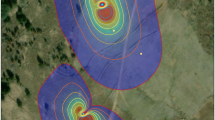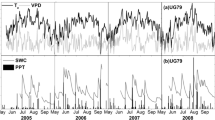Abstract
Environmental influences upon energy balance in areas of different vegetation types (i.e., forest at Kog-Ma in Thailand and at Yakutsk in Russia, grassland at Amdo in Chinese Tibet and at Arvaikheer in Mongolia, and mixed farmland at Tak in Thailand) in the GEWEX Asian Monsoon Experiment were investigated. The sites we investigated are geographically and climatologically different; and consequently had quite large variations in temperature (T), water vapor pressure deficit (VPD), soil moisture (SM), and precipitation (PPT). During May-October, the net radiation flux (R n) (in W·m−2) was 406.21 at Tak, 365.57 at Kog-Ma, 390.97 at Amdo, 316.65 at Arvaikheer, and 287.10 at Yakutsk. During the growing period, the R n partitioned into latent heat flux (λE/R n) was greater than that partitioned into sensible heat flux (H/R n) at Tak and at Kog-Ma. In contrast, λE/R n was lower than H/R n at Arvaikheer, H/R n was less than λE/R n between DOY 149 and DOY 270 at Amdo, and between DOY 165 and DOY 235 at Yakutsk. The R n partitioned into ground heat flux was generally less than 0.15. The short-wave albedo was 0.12, 0.18, and 0.20 at the forest, mixed land, and grass sites, respectively.
At an hourly scale, energy partitions had no correlation with environmental factors, based on average summer halfhourly values. At a seasonal scale energy partitions were linearly correlated (usually p<0.05) with T, VPD, and SM. The λE/R n increased with increases in SM, T, and VPD at forest areas. At mixed farmlands, λE/R n generally had positive correlations with SM, T, and VPD, but was restrained at extremely high values of VPD and T. At grasslands, λE/R n was enhanced with increases of SM and T, but was decreased with VPD.
Similar content being viewed by others
References
Baldocchi D D, Kelliher F M, Black T, Jarvis P (2000). Climate and vegetation controls on boreal zone energy exchange. Glob Change Biol, 6(S1): 69–83
Baldocchi D D, Vogel C A (1996). Energy and CO2 flux densities above and below a temperate broad-leaved forest and a boreal pine forest. Tree Physiol, 16(1–2): 5–16
Baldocchi D D, Xu L, Kiang N (2004). How plant functional-type, weather, seasonal drought, and soil physical properties alter water and energy fluxes of an oak-grass savanna and an annual grassland. Agric Meteorol, 123(1–2): 13–39
Barr A, Morgenstern K, Black T, McCaughey J, Nesic Z (2006). Surface energy balance closure by the eddy-covariance method above three boreal forest stands and implications for the measurement of the CO2 flux. Agric Meteorol, 140(1–4): 322–337
Barr A G, Betts A K, Black T, McCaughey J, Smith C (2001). Intercomparison of BOREAS northern and southern study area surface fluxes in 1994. J Geophys Res, 106(D24): 33543–33550
Burba G G, Verma S B, Kim J (1999). Surface energy fluxes of Phragmites australis in a prairie wetland. Agric Meteorol, 94(1): 31–51
Choi T, Hong J, Kim J, Lee H, Asanuma J, Ishikawa H, Tsukamoto O, Gao Z, Ma Y, Ueno K (2004). Turbulent exchange of heat, water vapor, and momentum over a Tibetan prairie by eddy covariance and flux variance measurements. J Geophys Res, 109(D21): D21106
Crow W T, Wood E F (2002). The value of coarse-scale soil moisture observations for regional surface energy balance modeling. J Hydrometeorol, 3(4): 467–482
Eugster W, Rouse W R, Pielke R A Sr, Mcfadden J P, Baldocchi D D, Kittel T G F, Chapin F S III, Liston G E, Vidale P L, Vaganov E, Chambers S (2000). Land-atmosphere energy exchange in arctic tundra and boreal forest: available data and feedbacks to climate. Glob Change Biol, 6(S1): 84–115
Foken T (2008). The energy balance closure problem: an overview. Ecol Appl, 18(6): 1351–1367
Gash J H C, Shuttleworth W J (1991). Tropical deforestation: albedo and the surface-energy balance. Clim Change, 19(1–2): 123–133
Gu L, Meyers T, Pallardy S G, Hanson P J, Yang B, Heuer M, Hosman K P, Riggs J S, Sluss D, Wullschleger S D (2006). Direct and indirect effects of atmospheric conditions and soil moisture on surface energy partitioning revealed by a prolonged drought at a temperate forest site. J Geophys Res, 111(D16): D16102, doi: 10.1029/2006JD007161
Hammerle A, Haslwanter A, Tappeiner U, Cernusca A, Wohlfahrt G (2008). Leaf area controls on energy partitioning of a temperate mountain grassland. Biogeosciences, 5(2): 421–431
Heusinkveld B G, Jacobs A F G, Holtslag A A M, Berkowicz S M (2004). Surface energy balance closure in an arid region: role of soil heat flux. Agric Meteorol, 122(1–2): 21–37
Hiyama T, Kochi K, Kobayashi N, Sirisampan S (2005). Seasonal variation in stomatal conductance and physiological factors observed in a secondary warm-temperate forest. Ecol Res, 20(3): 333–346
Kariyeva J, van Leeuwen W J D, Woodhouse C A (2012). Impacts of climate gradients on the vegetation phenology of major land use types in Central Asia (1981–2008). Frontiers of Earth Science, 6(2): 206–225
Komatsu H, Hotta N, Kuraji K, Suzuki M, Oki T (2005). Classification of vertical wind speed profiles observed above a sloping forest at nighttime using the bulk Richardson number. Boundary-Layer Meteorol, 115(2): 205–221
Komatsu H, Yoshida N, Takizawa H, Kosaka I, Tantasirin C, Suzuki M (2003). Seasonal trend in the occurrence of nocturnal drainage flow on a forested slope under a tropical monsoon climate. Boundary-Layer Meteorol, 106(3): 573–592
Kosugi Y, Takanashi S, Tanaka H, Ohkubo S, Tani M, Yano M, Katayama T (2007). Evapotranspiration over a Japanese cypress forest. I. Eddy covariance fluxes and surface conductance characteristics for 3 years. J Hydrol (Amst), 337(3–4): 269–283
Li S G, Eugster W, Asanuma J, Kotani A, Davaa G, Oyunbaatar D, Sugita M (2006). Energy partitioning and its biophysical controls above a grazing steppe in central Mongolia. Agric Meteorol, 137(1–2): 89–106
Masuda K (2004). Surface radiation budget: comparison between global satellite-derived products and land-based observations in Asia and Oceania. International Radiation Symposium 2004. Busan, Korea, 2004 (See http://www.jamstec.go.jp/frcgc/research/p2/masuda/radcmp/index.html)
Matsumoto K, Ohta T, Nakai T, Kuwada T, Daikoku K, Iida S, Yabuki H, Kononov A V, van der Molen M K, Kodama Y, Maximov T C, Dolman A J, Hattori S (2008). Energy consumption and evapotranspiration at several boreal and temperate forests in the Far East. Agric Meteorol, 148(12): 1978–1989
Meiyappan P, Jain A K (2012). Three distinct global estimates of historical land-cover change and land-use conversions for over 200 years. Frontiers of Earth Science, 6(2): 122–139
Monteith J L, Unsworth M H (1990). Principles of Environmental Physics (2nd ed). London: Edward Arnold, pp 291
Moore C (1976). A comparative study of radiation balance above forest and grassland. Q J R Meteorol Soc, 102(434): 889–899
Ohta T, Hiyama T, Tanaka H, Kuwada T, Maximov T C, Ohata T, Fukushima Y (2001). Seasonal variation in the energy and water exchanges above and below a larch forest in eastern Siberia. Hydrol Processes, 15(8): 1459–1476
Ohta T, Maximov T C, Dolman A J, Nakai T, van der Molen M K, Kononov AV, Maximov A P, Hiyama T, Iijima Y, Moors E J, Tanaka H, Toba T, Yabuki H (2008). Interannual variation of water balance and summer evapotranspiration in an eastern Siberian larch forest over a 7-year period (1998–2006). Agric Meteorol, 148(12): 1941–1953
Pielke R A Sr, Avissar R, Raupach M, Dolman A J, Zeng X, Denning A S (1998). Interactions between the atmosphere and terrestrial ecosystems: influence on weather and climate. Glob Change Biol, 4(5): 461–475
Rosset M, Riedo M, Grub A, Geissmann M, Fuhrer J (1997). Seasonal variation in radiation and energy balances of permanent pastures at different altitudes. Agric Meteorol, 86(3–4): 245–258
Shinoda M, Ito S, Nachinshonhor G, Erdenetsetseg D (2007). Phenology of Mongolian grasslands and moisture conditions. J Meteorol Soc Jpn, 85(3): 359–367
Sugita M, Nohara D, Miyazaki S, Yamanaka T, Kimura F, Yasunari T (2005). GAME Asian Automatic Weather Station Network (AAN) Data Set Ver.3.0, GAME CD No.13. In: T.E.R.C. GAME AAN Working Group Office, University of Tsukuba, Tsukuba, Ibaraki, Japan
Tanaka K, Ishikawa H, Hayashi T, Tamagawa I, Ma Y (2001). Surface energy budget at Amdo on the Tibetan Plateau using GAME/Tibet IOP98 data. J Meteorol Soc Jpn, 79(1B): 505–517
Tanaka N, Kume T, Yoshifuji N, Tanaka K, Takizawa H, Shiraki K, Tantasirin C, Tangtham N, Suzuki M (2008). A review of evapotranspiration estimates from tropical forests in Thailand and adjacent regions. Agric Meteorol, 148(5): 807–819
Tao F L, Zhang Z (2011). Dynamic response of terrestrial hydrological cycle and plant water stress to climate change in China. J Hydrometeorol, 12(3): 371–393
Thomas A (2000). Climatic changes in yield index and soil water deficit trends in China. Agric Meteorol, 102(2–3): 71–81
Toda M, Nishida K, Ohte N, Tani M, Musiake K (2002). Observations of energy fluxes and evapotranspiration over terrestrial complex land covers in the tropical monsoon environment. J Meteorol Soc Jpn, 80(3): 465–484
Wilson K, Goldstein A, Falge E, Aubinet M, Baldocchi D, Berbigier P, Bernhofer C, Ceulemans R, Dolman H, Field C, Grelle A, Ibrom A, Law B E, Kowalski A, Meyers T, Moncrieff J, Monson R, Oechel W, Tenhunen J, Valentini R, Verma S (2002). Energy balance closure at FLUXNET sites. Agric Meteorol, 113(1–4): 223–243
Wu J, Guan D, Han S, Shi T, Jin C, Pei T, Yu G (2007). Energy budget above a temperate mixed forest in northeastern China. Hydrol Processes, 21(18): 2425–2434
Xu Z X, Gong T L, Li J Y (2008). Decadal trend of climate in the Tibetan Plateau—Regional temperature and precipitation. Hydrol Processes, 22(16): 3056–3065
Xue B L, Kumagai T, Iida S, Nakai T, Matsumoto K, Komatsu H, Otsuki K, Ohta T (2011). Influences of canopy structure and physiological traits on flux partitioning between understory and overstory in an eastern Siberian boreal larch forest. Ecol Modell, 222(8): 1479–1490
Yao L, Zhao Y, Gao S J, Li F R (2011). The peatland area change in past 20 years in the Zoige Basin, eastern Tibetan Plateau. Frontiers of Earth Science, 5(3): 271–275
Author information
Authors and Affiliations
Corresponding author
Rights and permissions
About this article
Cite this article
Liu, F., Tao, F., Li, S. et al. Energy partitioning and environmental influence factors in different vegetation types in the GEWEX Asian Monsoon Experiment. Front. Earth Sci. 8, 582–594 (2014). https://doi.org/10.1007/s11707-014-0429-8
Received:
Accepted:
Published:
Issue Date:
DOI: https://doi.org/10.1007/s11707-014-0429-8




